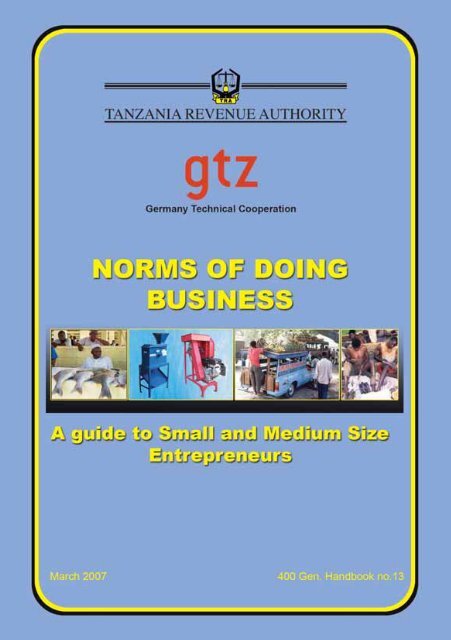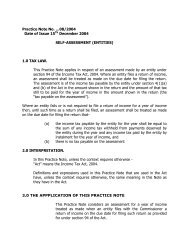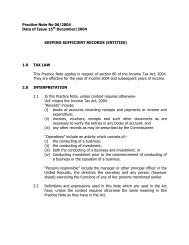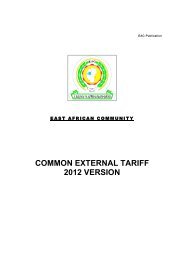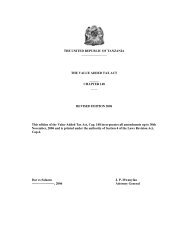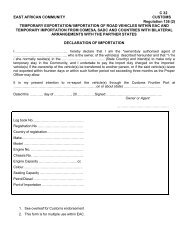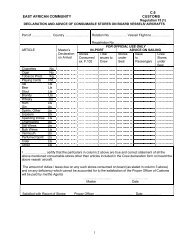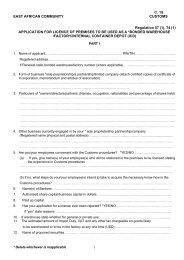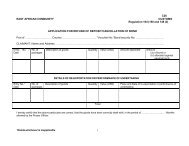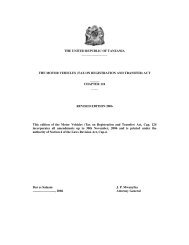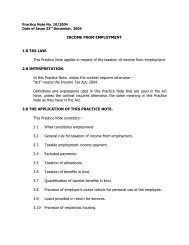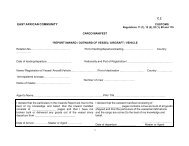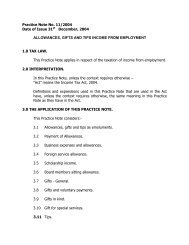Contents - Tanzania Revenue Authority
Contents - Tanzania Revenue Authority
Contents - Tanzania Revenue Authority
Create successful ePaper yourself
Turn your PDF publications into a flip-book with our unique Google optimized e-Paper software.
CONTENTS<br />
PREFACE . . . . . . . . . . . . . . . . . . . . . . . . . . . . . . . . .(i)<br />
1.0 ART OF ENTERPRENEURSHIP AND<br />
STARTING A NEW BUSINESS . . . . . . . . . . . . . . . . .1<br />
2.0 DEVELOPING YOUR BUSINESS WITH<br />
CUSTOMER FOCUS . . . . . . . . . . . . . . . . . . . . . . . . .8<br />
3.0 DEVELOPING A SUCCESSFUL<br />
BUSINESS STRATEGY . . . . . . . . . . . . . . . . . . . . . .10<br />
4.0 EFFECTIVE SALESMANSHIP . . . . . . . . . . . . . . . .14<br />
5.0 PILLARS OF YOUR BUSINESS . . . . . . . . . . . . . . .19<br />
6.0 BUSINESS RECORDS . . . . . . . . . . . . . . . . . . . . . .21<br />
7.0 TYPES OF TAXES AND HOW TO<br />
CALCULATE THEM . . . . . . . . . . . . . . . . . . . . . . . . .23<br />
8.0 CONCLUSION . . . . . . . . . . . . . . . . . . . . . . . . . . . . .37<br />
i
PREFACE<br />
<strong>Tanzania</strong> <strong>Revenue</strong> <strong>Authority</strong> (TRA) in collaboration with the Zanzibar<br />
<strong>Revenue</strong> Board (ZRB) has decided to introduce seminars on<br />
entrepreneurship skills to small and medium taxpayers. The main<br />
objective of conducting seminars in entrepreneurship is to create<br />
awareness among entrepreneurs and future entrepreneurs as a<br />
prerequisites for starting and managing a sustainable business<br />
enterprise. This move has been triggered by the fact that the taxpayer<br />
is the main player in mobilizing revenue for the two governments of<br />
the United Republic of <strong>Tanzania</strong> and that of the Revolutionary<br />
Government of Zanzibar. On this note, seminars in entrepreneurship<br />
will be conducted to involve small and medium taxpayers and<br />
stakeholders in tax management.<br />
Small and medium size entrepreneurs contribute greatly to the<br />
Government efforts towards economic growth and poverty<br />
eradication under MKUKUTA, for Mainland <strong>Tanzania</strong> and MKUZA for<br />
Zanzibar. It is therefore important for TRA and ZRB to observe their<br />
role as partners in revenue collection and provide training to other<br />
stakeholders on how to effectively manage business, increase sales<br />
and sustain in business environment.<br />
This publication for small and medium taxpayers has been released<br />
at a time when the fourth phase Government of United Republic of<br />
<strong>Tanzania</strong> is determined to improve the livelihood of <strong>Tanzania</strong>ns<br />
through various strategies. The book gives a brief explanation on the<br />
art of entrepreneurship, advantages of entrepreneurship education<br />
such as; expanding businesses, how to increase income that<br />
ultimately leads to poverty alleviation in our communities, creating<br />
employment opportunities, widening of the tax base of collection and<br />
increasing government revenue.<br />
During various seminars regularly conducted by revenue authorities<br />
on the tax laws, regulations and payment of tax, the need for<br />
entrepreneurship education to the taxpayers has clearly been noted.<br />
Many taxpayers do not know much about entrepreneurship and its<br />
role in business promotion. They lack tactics of business<br />
ii
administration, management skills with a customer focus and<br />
knowledge of effective salesmanship. They cannot meet the<br />
challenges of competition; and they are not exposed to the art of<br />
records keeping.<br />
It is our sincere hope that this book will be useful to all stakeholders<br />
as it has focused on entrepreneurs specific goals such as: How to<br />
assist an entrepreneur in developing his/her business, how to impart<br />
skills in record keeping in order to monitor business transactions,<br />
ways of increasing openness in tax collection and disperse fear from<br />
Small and Medium Enterprisers, (SMEs). The book also attempts to<br />
create better business expectations of business operations; and how<br />
to create a healthy relationship between taxpayers and tax authorities<br />
as an important component towards success in business.<br />
The preparation and publication of this book was made possible<br />
through the co-operation and the assistance of Gtz through their tax<br />
consultant Mr. Bernd Nuedling which supports TRA both materially<br />
and financially. Appreciation also goes to Mr. Paul T. Chizi MD of<br />
Customer Support Systems Ltd. for their valuable advice as<br />
consultants on the adequacy and quality of the materials in this<br />
publications.<br />
iii
PART ONE<br />
1.0 ART OF ENTREPRENEURSHIP STARTING A NEW<br />
BUSINESS<br />
1.1 ART OF ENTEPRENEURSHIP<br />
The word entrepreneurship comes from the word<br />
enterprise and means:<br />
• Determination to look for and eagerness to get wealth<br />
• The ability to identify existing opportunities and courage to<br />
exploit emerging opportunities<br />
• The ability to overcome obstacles that may hinder<br />
business operations.<br />
Therefore an entrepreneur is a person who is able to identify<br />
and exploit existing opportunities to establish and manage<br />
viable enterprises by applying the main pillars of business,<br />
which are; manpower resources and working capital. He is a<br />
planner with a vision and mission who is dedicated to run<br />
his/her business with success. He is also confident, selfdriven<br />
ready to work for long hours; a person who is quick to<br />
realize his/her mistakes and take remedial measures; and<br />
one who is willing to spot out other talents and use them to<br />
accomplish business plans<br />
1.2 MEANING OF BUSINESS<br />
Business is an act of buying and selling property, goods<br />
and/or delivering services, with the aim of earning profit.<br />
The national policy of 2003 of developing small and medium<br />
size entrepreneurs divides businesses into four main<br />
categories by considering the number of employees and<br />
operating capital as follows:-<br />
1
SN BUSINESS TYPE NO. OF<br />
EMPLOYEES<br />
BUSINESS CAPITAL<br />
1. Minor enterprise 1 to 4 Under TZS 5,000,000/=<br />
2. Small enterprise 5 to 49 From TZS 5,000,000/=<br />
3. Medium enterprise 50 to 99<br />
To TZS 200,000,000/=<br />
From TZS 200,000,000/=<br />
To TZS 800,000,000/=<br />
4. Large Enterprise Over 100 Over TZS 800,000,000/=<br />
Table no 1: CATEGORIES OF BUSINESS<br />
Other criteria used by <strong>Tanzania</strong> <strong>Revenue</strong> <strong>Authority</strong> to determine<br />
categories of taxpayers are the yearly net-capital sales or the<br />
magnitude of taxes one pays per year.<br />
As business location has a great influence on the performance of<br />
an enterprise, you should therefore: -<br />
• Make sure that your business site is legally recognized in<br />
terms of land registration and building permits<br />
• Identify existing institutions, resource people, and<br />
government departments which can play a role in<br />
strengthening your business<br />
• Make sure that there exists the necessary business<br />
infrastructure (roads, water, electrical supply, etc.)<br />
1.3 CONSIDERATIONS FOR DETERMINING THE RIGHT<br />
BUSINESS<br />
Before you engage in business, you should decide what type<br />
of enterprise you would operate by considering the following<br />
parameters:-<br />
• The availability of raw materials, goods or services, you<br />
want to sell or offer<br />
• Competitors against your business<br />
• Market for your goods, and interests of the customers<br />
• Running cost of your business<br />
• Procedures of paying taxes and various fees<br />
2
• The climate of your business location<br />
• Living environment of the people around (peace and<br />
tranquility, wars, peoples income, etc)<br />
1.4 THE RIGHT BUSINESS PARTNER<br />
Having confirmed your business location and the necessary<br />
infrastructure in terms of human resources, related<br />
institutions, and relevant government departments, you<br />
should look into other criteria of selecting the right business<br />
partner.<br />
• Do you have the capacity to effectively run your own<br />
business? If yes, do you have the necessary skills to<br />
manage your enterprise?<br />
• Is it logical to manage the business alone or there is a<br />
need to form partnership with other people? Here you<br />
should take into account how you can run your enterprise<br />
during times of sickness, emergency, etc.<br />
• Have you observed all legal measures of establishing your<br />
partnership or cooperation?<br />
In looking for the right business partner, consider the<br />
following:-<br />
• The partner should be ready to take business risks.<br />
• Should have appropriate education and relevant skills to<br />
run the business.<br />
• Should have a vision and ambition of sustaining the<br />
business.<br />
• Should be willing to commit dedication, time, resources,<br />
and energy in order to develop the business.<br />
1.5 DETERMINING THE BUSINESS STRUCTURE<br />
Knowledge of different forms of business will enable you to<br />
choose the appropriate structure for your new enterprise. The<br />
following are some of the forms of business.<br />
3
• Sole proprietorship<br />
• Partnership<br />
• Private/Public company<br />
(a) Sole Proprietorship<br />
This type of business is solely owned by a person assisted by<br />
his/her children or spouse. The owner, may employ a<br />
manager but he/she remains the final decision maker and<br />
responsible for debt obligations of the company. In case of<br />
bankruptcy, the owner of the company will meet all<br />
obligations, profit and liabilities.<br />
This type of business structure has no requirement other than<br />
working capital, business license, and company registration<br />
and enterprise management. Its disadvantage is that<br />
everything lays on the owner’s shoulders. When his/her falls<br />
sick or entangled in problems, your business will certainly fall.<br />
Its advantage is that the owner has the freedom to plan and<br />
develop his business at a desired pace.<br />
(b) Partnership<br />
Partnership is made of two or more people (not more than 20)<br />
who have decided to join hands in business. The advantages<br />
of this structure are as follows:-<br />
• Develops working capital<br />
• Diversified skills as partners complement their business<br />
knowledge and experiences<br />
• Lowers tax rates in comparison to a sole trade (look at the<br />
example in section seven).<br />
• Each partner is bonded to the business; and all of them<br />
are liable to the business debts.<br />
(c) Company<br />
Companies fall into two categories namely: the private and<br />
4
public company. This type of companies is bonded to the<br />
enterprise and its debts and the business transactions have<br />
no relationship to the individual property of its owners. In case<br />
of bankruptcy, and if the debts exceed the company property,<br />
the liquidator will have no mandate to seize individual<br />
property of the directors or shareholders.<br />
Before one determines the structure of his/her intended<br />
business, it is better to ask the following questions.<br />
• Which structure is suitable for your capital?<br />
• Which structure has less legislative conditions?<br />
• Which structure will incur less taxes and fees?<br />
• Which structure offers a better flexibility?<br />
1.6 BUSINESS REGISTRATION<br />
Any business has to be legally registered. You should register<br />
your business with relevant institutions, and related<br />
government departments in order to legalize your enterprise.<br />
In the cause of registration, make sure you get all receipts and<br />
necessary documents. Abide by Legislative procedures to<br />
avoid unnecessary future disturbances.<br />
The conditions that are listed at the backside of a trading<br />
licence are as follows: -<br />
• The Licensee in not allowed to put any conditions to the<br />
buyer<br />
• The Licensee shall issue receipt for each sale he makes<br />
• The Licensee shall adhere to the provisions of the Trade<br />
License Act (No. 25) of 1972 together with its<br />
amendments (No.9) of 1980<br />
• The Licensee shall not provide services or goods, which<br />
are substandard as per recognized institutions that control<br />
quality standards.<br />
• The trading license may be impounded any time if found<br />
to be illegally obtained or violation of conditions of the<br />
license.<br />
The act of doing business without a trading license is an<br />
5
offence and upon conviction the licensee is liable to a fine of<br />
TZS 50,000 but not more than TZS 100,000 or imprisonment<br />
for a term of not more than two (2) years or both fine and<br />
imprisonment.<br />
In order to be considered for issuance of trading license must<br />
posses the following qualifications: -<br />
• Your age should be not less than 18 years old<br />
• Ensure that you have an authorized place of business<br />
• Should be sane<br />
• Should be a good citizen without criminal offences and if<br />
not a citizen you must have Class A permit from<br />
Immigration Department.<br />
1.7 RAISING CAPITAL FOR YOUR BUSINESS<br />
Business capital can be raised from your own saving or funds<br />
from your colleagues. You can obtain loans from financial<br />
institutions such as Banks, Pride, Finca, Poverty Africa, etc.<br />
You can also take advantage of the government strategies<br />
such as MKUKUTA, MKUZA, MKURABITA, etc.<br />
Make sure you fully exploit these opportunities to raise and<br />
develop your business. Other opportunities at hand are<br />
SACCOS, and the special funds allocated to each region by<br />
the Government.<br />
1.8 APPOINTING THE MANAGEMENT FOR YOUR BUSINESS<br />
You should assess your own potential and the potentials of<br />
your partners and workforce to meet the goals of your<br />
business. After identifying the strengths and weaknesses of<br />
everyone who is part of the business, appoint competent<br />
managers who will lay out plans and strategies to develop the<br />
business. Without qualified managers, it shall be difficult to<br />
achieve the set objectives.<br />
If you do not have among yourselves, a person with the<br />
desired qualities, you should employ an expert to run your<br />
6
usiness.<br />
1.9 BUSINESS FAILURE/SUCCESS<br />
Business is started to become sustainable. Nobody who<br />
establishes a business would like to see it dying eventually.<br />
The question to ask ourselves is “Why do businesses fail?”<br />
According to surveys conducted in America in 1981, it was<br />
established that, out of 100 enterprises that were started, 65<br />
died within three years, and 17 out of the remaining business<br />
died in the following two years. This means that only 18% of<br />
the enterprises exist beyond the first 5 years. What is the<br />
status in <strong>Tanzania</strong>?<br />
In <strong>Tanzania</strong> some of the businesses once established are not<br />
sustainable due to the following reasons: -<br />
• Insufficient capital<br />
• Inadequate business knowledge and skills<br />
• Poor business management (selfishness, low integrity<br />
etc)<br />
• Wrong business location<br />
• Unexpected business competition<br />
• Unfriendly laws<br />
• Bankruptcy<br />
• Lack of customer focus<br />
• Hazards and calamities<br />
1.10 PRODUCT STANDARDS AND CERTIFICATION<br />
For a successful business the entrepreneur should ensure<br />
that the product that is trading with must have a certification<br />
of its specifications approved by a recognized government<br />
institution or authority. This is purely for healthy/safety, social,<br />
and economic and for security reasons. For example locally<br />
produced products should be certified with the <strong>Tanzania</strong><br />
Bureau of Standards. For exports of agricultural products<br />
they should conform with the Sanitary and Python-Sanitary<br />
Standards, or should have Product Certification/Quality<br />
Standards such as ISO, Organic Product Certification<br />
7
Schemes.<br />
PART TWO<br />
2.0 DEVELOPING YOUR BUSINESS WITH CUSTOMER<br />
FOCUS<br />
Who is a customer?<br />
Customer is a person, company, institution, or group of people<br />
who buy goods or services from you. He/she can come from<br />
within or outside the business entity.<br />
2.1 Customer Care Philosophy<br />
A customer is the boss and a pillar of business success.<br />
The aim of any business be it production, trading or provision<br />
of service, is to realize profit to satisfy the needs of the owner.<br />
Customer care is the main approach that will consolidate your<br />
business and increase your income. You will develop your<br />
business if you offer good services that will satisfy customer<br />
demand and attract other customers to come and buy or get<br />
services from you.<br />
2.2 Factors that may lead to business growth<br />
• To raise prices on goods or services. This approach may<br />
not be successful and could drive away customers.<br />
• To lower or retain prices thereby increasing the number of<br />
customers and sales of goods or services.<br />
• To know customer expectations and satisfy their demand.<br />
• A customer who is not satisfied by your goods or services<br />
will discourage others not to come and buy from you.<br />
The philosophy of customer care is “alpha and omega” of your<br />
business. This means that the customer will contribute to the<br />
development of your business by praising it such that other<br />
people will be tempted to come and buy/get services from<br />
you. A customer may send away other customers by<br />
8
negatively publicizing your business.<br />
2.3 IMPORTANT POINTS TO NOTE ON CUSTOMER CARE<br />
The entrepreneur should be aware of various factors in caring<br />
his/her customers.<br />
• To view the customer as the essence of your business by<br />
recognizing his/her values. No customers no business<br />
• To develop the culture of valuing your workers. It is the<br />
worker who meets the customers and may build the<br />
reputation of your business or destroy it.<br />
• To see things from the customer’s viewpoint.<br />
2.4 BUILDING A SUSTAINABLE BUSINESS<br />
Factors that make businesses sustainable will be discussed<br />
in depth in their respective sections; however some of these<br />
factors are: -<br />
• Select the appropriate model for your business after<br />
partnership, company, cooperatives and corporation.<br />
• Appoint competent leadership and skilled labour with<br />
customer focus.<br />
• Place your business in proper location.<br />
• Develop appropriate strategies to address business<br />
competition.<br />
• Prepare and maintain a proper balance sheet.<br />
9
PART THREE<br />
3.0 DEVELOPING A SUCCESSFUL BUSINESS STRATEGY<br />
3.1 STRATEGY VIS-À-VIS BUSINESS VISION AND MISSION<br />
It is important to match the vision and mission of your<br />
business. This will mean that you have to evolve strategies<br />
that will focus on the mission of the business vision.<br />
3.2 BUSINESS STRATEGIES<br />
In order to succeed in trading or service delivery, one should<br />
ask the following questions:<br />
• What type of goods or services do you want to offer, now<br />
and in future?<br />
• What kind of customers do you intend to serve, now and<br />
in future?<br />
• In which areas (e.g. within <strong>Tanzania</strong>, East Africa, Africa or<br />
Overseas) should you expand your business and why?<br />
• How do you distinguish yourself from your business<br />
competitors, now and in future?<br />
• What competitive strategies do you deploy in order to<br />
thrive and reach your business targets?<br />
• What commitments do you make to the society?<br />
• What benefits are your employees deriving from your<br />
business?<br />
Answer to these questions will determine your customers,<br />
future customers, ways of reaching them, competitive<br />
strategies, financial rewards and the expected contribution of<br />
your business to the socio – economic growth of your<br />
community.<br />
After laying out the strategies, you can now workout yearly<br />
10
plans to achieve the mission of your business. It is therefore<br />
important to make regular evaluation of the business trend to<br />
ensure conformity with your business plan.<br />
3.3 EVALUATE BUSINESS ENVIRONMENT<br />
A serious entrepreneur who is looking for a success in<br />
business will initially carry out an environmental assessment.<br />
This is because the environment may boost your business,<br />
stagnate it or kill it. Your evaluation should take into account<br />
the internal and external features of your enterprise.<br />
3.3.1 Internal environment of your business<br />
In order for your business to thrive, it is recommended to<br />
make thorough assessment of the internal factors.<br />
(a) Capacity<br />
Determine your ability, understanding and the scope of your<br />
vision for the business you aspire to undertake by evaluating:-<br />
• Your capital. Make sure you have enough capital to<br />
effectively run your business.<br />
• Quality of your goods and services<br />
• Knowledge of your customers and their customs<br />
• Understand your business competitors<br />
• Knowledge and skill of the business.<br />
(b) Weaknesses<br />
It is important to understand the weaknesses that may affect<br />
the growth of your business, for example:-<br />
• Lack of customer focus<br />
• Lack of techniques for overcoming competition<br />
• Supply of goods and services not timely delivered<br />
3.3.2 External environment of the business<br />
Determine the opportunities and threats of your enterprise so<br />
as to lay out viable strategies for developing your business.<br />
11
(b) Opportunities<br />
• External capital, for example, aid, grants, loans, etc.<br />
• A conducive business environment will attract investors to<br />
enter into partnership with local entrepreneur e.g.<br />
<strong>Tanzania</strong> Certificate of Incentive to investors.<br />
• The establishment of the East African Common Market<br />
that will expand the scope of business undertaking.<br />
(b) Threats<br />
• Internal competition<br />
• External competition from multinational companies which<br />
invest in our country<br />
• Change in legislations, which do not favour local<br />
industries or business enterprises<br />
• Business environment in <strong>Tanzania</strong> can be difficult for<br />
SMEs to conduct effective business due to multiple<br />
licenses or permits, contract enforcement. However the<br />
government is trying to streamline and simplify the<br />
procedures with a view to facilitate business.<br />
3.4 ENVIRONMENTAL SCANNING: CURRENT AND FUTURE<br />
The PESTL analysis:<br />
(a) Political<br />
The political trend may negatively or positively affect<br />
your business.<br />
(b) Economic<br />
A health economic environment will empower the<br />
people to buy your goods or services. How much does<br />
the government play its part in improving the business<br />
environment for the local entrepreneur? (Consider the<br />
necessary social infrastructures of law and order,<br />
means of transport, road network, health facilities,<br />
etc.)<br />
12
(c) Social<br />
How does:-<br />
• The community gains from the sales of your goods<br />
or services?<br />
• How does your business protect the environment?<br />
(d) Technological<br />
• Ho do you intend to take your business beyond the<br />
borders. Taking advantages of opportunities that<br />
exist in East African Customs Union and SADC.<br />
• Do your working equipment conform to the everchanging<br />
technology?<br />
(e) Legal<br />
How does the legal framework protect the local<br />
entrepreneur?<br />
13
PART FOUR<br />
4.0 EFFECTIVE SALESMANSHIP<br />
The purpose of a business is to generate income. Expertise in<br />
salesmanship will develop your business, deliver necessary<br />
requirements, and improve your well being.<br />
4.1 DEPLOY GOOD SALESMEN /WOMEN<br />
In the cause of selling goods/services, lay sound strategies in<br />
promoting your business. These strategies include:-<br />
(a) Ways of reaching the customers<br />
(i) Advertise you business using the media such as TV, radio,<br />
placards, publications, etc.<br />
(ii) Buy the idea that, “Business advertised is business<br />
delivered.”<br />
• If necessary, take your goods to the customer’s door<br />
• Where possible employ agents.<br />
• Visit your customers to promote your goods and get<br />
their feeling about your business.<br />
• Use questionnaires to explore market demand for your<br />
goods or services.<br />
(b) Differentiate yourself from your competitors<br />
Your business will thrive if you display your goods through<br />
different ways from that of your competitors<br />
• Offer competitive prices to your main customers.<br />
• Decrease prices beyond those of your competitors to<br />
attract customers.<br />
• Introduce psychological reductions of price and business<br />
trade mark.<br />
• Announce grand price deductions for out fashioned<br />
14
products.<br />
• Employ attractive salesmen/women who offer better<br />
customer care than your competitors (smiling, receptive,<br />
presentable, etc).<br />
• Make good display of your goods in your shop.<br />
(c) Identify your customers<br />
Considering the social diversity of our communities, a<br />
businessman has an opportunity to dispose of his/her goods<br />
or services if he capitalizes on the social groupings. The<br />
society falls into different categories in conformity with their<br />
cultures traditions, social norms, economic status, behavior<br />
etc.<br />
In that case you can sell your goods or services in line with<br />
the aforesaid divisions.<br />
• Identify areas where you can sell products of a certain<br />
quality.<br />
• Determine the economic status of your customers.<br />
• Observe the culture and social behavior of the society in<br />
relation to the quality of your goods.<br />
• Determine the needs and expectations of each group of<br />
customers.<br />
4.2 OVERCOMING YOUR COMPETITION<br />
Address the following basic issues:<br />
• Do your actions, goods and services attract customers?<br />
• Do you understand the needs of your customers?<br />
• Of what benefit are your goods and services to the<br />
customers?<br />
• Constantly compare your prices to those of your<br />
competitors.<br />
4.3 NORMS OF SALESMANSHIP<br />
When selling goods, observe the followings:-<br />
15
• Attract customers to buy at first sight.<br />
• Create good impression to your customers.<br />
• Make sure you use the initial few words to sell your goods.<br />
• Keep records of important elements of your customers to<br />
be able to mention their names when they come to buy<br />
from you.<br />
• Develop courage to look straight into the faces of your<br />
customers when you are doing business with them.<br />
4.4 COST CONTROL<br />
You should be cost conscious in order to reduce running cost<br />
of the business. The following ways will guide you in reducing<br />
or avoiding unnecessary costs and making profit. Cutting<br />
down costs of procurement and business administration will<br />
enable to expand your enterprise. You may categorize these<br />
costs in three groups<br />
(a) Procurement and storage of goods<br />
Before you indulge in procurement of goods, ask<br />
yourself the following questions:-<br />
• Are the goods you want to buy easy to sell? Does<br />
the market need them? (in terms of quality, price,<br />
environment, etc).<br />
• Is the source of supply to acceptable standard?<br />
(in terms of distribution, price, processing, etc)<br />
(b) Management of goods<br />
Procurement of goods contributes greatly to the over<br />
all cost of business and should therefore be monitored<br />
very closely.<br />
Ways to restrict cost in procurement and improve<br />
business<br />
performance are:<br />
• Lead time<br />
The businessman/women should have a<br />
timetable to lead him/her in making<br />
procurements from the time of ordering to the<br />
16
securing of goods, before available goods are<br />
obsolete or get to minimum stock level. If new<br />
supply is delayed current stock may get finished<br />
and disturb the flow of business.<br />
• Economic Order quantity<br />
Before you decide how much you want to order<br />
you have to underscore the cost implications of<br />
buying large quantities and storing part thereof<br />
or ordering more than once. If the costs of<br />
making a single order are greater than that of<br />
several orders or vice versa, that kind of order is<br />
not beneficial to you. An economic order is<br />
achieved when the cost of a single order is equal<br />
to that of storage; for further explanation, refer to<br />
the diagram below: -<br />
CHANGES IN STORAGE, PROCUREMENT AND SALES OF<br />
_<br />
______ _____________________<br />
_______________________________ ____<br />
17
GOODS<br />
(c) Running Cost<br />
• Avoiding unnecessary costs by reducing family<br />
expenditure and ensuring you do not spend more than<br />
you can afford.<br />
• Reduce administrative cost (such as water bills,<br />
electricity, telephones, etc).<br />
• Do not buy unnecessarily expensive furniture.<br />
4.5 Other operating costs<br />
Avoid penalties for non-compliance with statutory payments<br />
(Taxes for TRA /ZRB, City/Municipal/Town Councils, Licence,<br />
etc)<br />
18
PART FIVE<br />
5.0 PILLARS OF YOUR BUSINESS<br />
It is important to realize that whenever you engage in<br />
business there is a silent partner in business engaged in<br />
creating the right environment for your business. This<br />
silent partner is the government as it ensures that roads,<br />
hospitals, utilities schools are in good condition for the<br />
conveniences running of your business.<br />
It is therefore imperative that part of the profit that accrues<br />
is paid to your silent partner. This type of dividend is<br />
generically called tax. It is therefore important to operate<br />
your business in a transparent manner so that each party<br />
in the business (also the tax administration) can have<br />
access to the information and be satisfied.<br />
5.1 DISTRIBUTION OF DIVIDEND<br />
5.2 Government Dividend<br />
• The government dividend forms the expenditure of her<br />
yearly budget. This dividend is known as tax, a name that<br />
is misinterpreted and given a negative connotation,<br />
making its collection difficult.<br />
• Training in tax management is meant to make you aware<br />
of your responsibility of paying government taxes<br />
voluntarily and educate your neighbours who are yet to<br />
receive this education, of their duty of paying their<br />
respective fees and taxes.<br />
5.3 Dividend of the Entrepreneur<br />
• Your dividend is the remaining part of the profit of your<br />
business after you have paid government taxes. You can<br />
use it for your current and development expenditures and<br />
even boost the capital of your business or start a new<br />
business out of the education, knowledge and skills you<br />
19
have obtained from this training.<br />
• Your dividend is part of the profit, an attractive name in<br />
the ears of everyone, who hears it. If you do not have<br />
these pillars, your business will tend to fall, changing the<br />
profit into a loss.<br />
• This publication reminds you of your noble responsibility<br />
registering your business and obtaining the Taxpayer<br />
Identification Number (TIN). Future expectation is to see<br />
your business records showing the progression of your<br />
business for your sake, community and the nation at large.<br />
20
6.0 BUSINESS RECORDS<br />
PART SIX<br />
In the last section we underscored the need for transparency<br />
in managing your business. This essentially emphasizes the<br />
need of keeping proper records. This section shall dwell much<br />
more deeply on record keeping.<br />
6.2 WHAT ARE RECORDS?<br />
• A record is anything that contains information for one to<br />
remember.<br />
• In business, records refer to documents for<br />
•<br />
remembrance/reference.<br />
Documents for remembrance are written specifically to<br />
enable the stakeholder remember or create in his/her<br />
mind the real picture of the flow of the business.<br />
6.2 THE NEED FOR BUSINESS RECORDS<br />
• Proper records will reveal the actual profit of the business.<br />
• Records assist in tracing the flow of business and its<br />
corresponding income.<br />
• Records assist in confirming or giving testimony to a<br />
business transaction, for example, procurement of good<br />
without receipts, or buying illegal property.<br />
• Proper records enable the business stakeholder to know<br />
his real income and determine the actual taxes he/she has<br />
to pay.<br />
• Records enable the entrepreneur to determine his/ her<br />
needs from business investors, from within or outside the<br />
country. For example, getting loans or business skills from<br />
various institutions.<br />
Every business man/woman is required to keep records and<br />
books of accounts of his/ her business. Records should be<br />
kept within the prescribed time frame. Failure to keep proper<br />
records is illegal.<br />
21
6.3 TYPE OF RECORDS<br />
There are many business records that are grouped according<br />
to the size of the enterprises. Some of them are:-<br />
• Receipts of sales and purchases<br />
• Copies of tax invoice which were issued showing VAT that<br />
was collected<br />
• Copies of tax invoice which were received during<br />
purchases showing VAT payments<br />
• Debit and Credit Notes<br />
• VAT account<br />
• Purchase day book<br />
• Sales day book<br />
• Production records of industrial goods and how they are<br />
distributed<br />
• Accounts showing yearly income and expenditure and the<br />
final accounts of business<br />
• Cashbook, petty cash, and other books of accounts<br />
• Business communications<br />
• Bank statement<br />
• Records stored in a computer.<br />
22
PART SEVEN<br />
7.0 TYPES OF TAXES AND HOW TO CALCULATE THEM<br />
7.1 VALUE ADDED TAX (VAT)<br />
VAT is a consumption tax charged by VAT registered traders<br />
on all taxable goods and services at a standard rate of 20%.<br />
The VAT is a multistage tax levied at each stage of production<br />
and distribution up to the retail stage. The tax is also levied on<br />
taxable imports made by persons whether or not registered<br />
for VAT.<br />
All traders whose taxable turnover exceeds TZS 40 million per<br />
annum (for <strong>Tanzania</strong>n Mainland) and TZS 20,000,000 (for<br />
Zanzibar) are obliged to apply for VAT registration to the<br />
respective Commissioners in their respective Tax <strong>Authority</strong>.<br />
They are also required by law to keep records and books of<br />
accounts of their business.<br />
(a) VAT ACCOUNT<br />
This shows, on one hand, a brief report of tax collection on<br />
sales and any changes in tax collection and on the other hand<br />
a brief report of taxes paid on purchases and any changes<br />
made in taxes, which were paid. Thus the actual VAT paid or<br />
remitted shall be realized.<br />
You are supposed to keep VAT brief reports within the period<br />
of VAT returns. Add the columns of VAT in your books of<br />
account regularly, say weekly, and the sum should be written<br />
in briefs under the following headings:-<br />
Table no: 2 VAT ACCOUNT<br />
S/N VAT ON PURCHASES VAT ON SALES<br />
1. Internal purchases Sales<br />
2. Imports of goods Goods for personal use<br />
3. Errors of previous returns Errors on previous returns<br />
Total Total<br />
23
At the end of each tax period add the figures on each heading<br />
and insert them on your VAT returns.<br />
(b) HOW TO CALCULATE VAT ON SALES<br />
If VAT is inclusive in the sales of goods or services, the result<br />
is a “price that includes VAT”.<br />
The VAT fraction is r , where r = tax rate.<br />
(r + 100)<br />
Using VAT tax rate of 20%, VAT on sale and purchase can be<br />
obtained by using the VAT fraction 20/120 of the VAT included<br />
price.<br />
Example 1<br />
BAHATI bought goods worthy TZS 1,200/=, VAT included.<br />
The value of VAT can be determined as follows: -<br />
By using the VAT fraction<br />
VAT : 20 x 1,200 = TZS 200/=<br />
120<br />
The actual value of goods shall be obtained by subtracting<br />
VAT from the gross values of goods, i.e.<br />
Actual Value of goods = Value inclusive of VAT – VAT<br />
= TZS 1,200 – TZS 200 = TZS 1,000<br />
Therefore:<br />
• VAT on goods shall be TZS 200<br />
• Actual value of goods is TZS 1,000<br />
Example 2<br />
How to calculate VAT on goods or services that are VAT<br />
exclusive<br />
.<br />
BAHATI is an entrepreneur of a whole sale shop, who is VAT<br />
24
egistered for the tax period of November, 2006; she has<br />
bought and sold goods as follows:<br />
Value of goods bought (VAT excluded) TZS 100,000.00<br />
VAT on purchases (20%) TZS 20,000.00<br />
Value of goods with VAT TZS 120,000.00<br />
Profit on sales is as follows:<br />
Value of goods without VAT TZS 100,000.00<br />
Profit and expenses TZS 20,000.00<br />
Selling price without VAT TZS 120,000.00<br />
Add VAT on sales (20%x 120,000/=) TZS 24,000<br />
Selling price with VAT TZS 144,000.00<br />
At the end of the month the VAT to be paid from returns of<br />
November 2006, shall be:-<br />
VAT on sales TZS 24,000.00<br />
Subtract VAT on purchases TZS 20,000.00<br />
VAT to be paid to Tax <strong>Authority</strong> TZS 4,000.00<br />
7.2 CUSTOMS DUTY AND EXCISE DUTY<br />
7.2.1 Customs Duty: Customs duty is levied on imported goods<br />
7.2.2 Excise Duty: Excise duty is levied on certain specified<br />
imported goods like wines, spirits, cigarettes, petroleum<br />
products and non-utility cars. It is also levied on specified<br />
local produced goods and services. The duty is charged at<br />
specific or ad-valorem rates.<br />
7.2.3 Common External Tariffs for East Africa Community:<br />
Imports from East Africa Community member states are<br />
chargeable at the rates enshrined in the Common External<br />
Tariff.<br />
Anybody can import goods into the country after observing<br />
customs regulations on imports. You are supposed to know<br />
whether the goods you want to import are legally allowed into<br />
the country or not. There are goods that are prohibited to<br />
25
enter into the country for example, intoxicating drugs,<br />
equipment for tear gas, inciting literature, abuses, etc. There<br />
are also restricted goods which law permit to enter the country<br />
with further permission from relevant government institutions,<br />
e.g. Live animals, crops, blasts and fire arms. You should<br />
know the authorities and institutions concerning the<br />
importation of such goods.<br />
According to the present system of clearing goods from<br />
customs, there are certain types of goods that are cleared<br />
immediately for security and safety reasons eg explosives or<br />
perishable items or as a way of facilitating business such as<br />
raw materials or equipment. Registered Customs Clearing<br />
Agents with TRA carry out the function of clearing imported<br />
goods.<br />
Imported goods may bear a custom clearance certificate for<br />
home consumption, or transit or bonded warehouse. Goods<br />
for home consumption have to be charged custom duty,<br />
excise duty (if any) and VAT; unless such goods are exempted<br />
or the person concerned is exempted from tax. The duty rates<br />
differ according to the type of goods and their place of origin.<br />
Goods with Certificate of Transit are not charged tax and are<br />
kept under the supervision of the Custom and Excise<br />
Department until they cross borders and reach the country of<br />
destination.<br />
Goods certified for warehousing are not charged tax until they<br />
are cleared and declared for home consumption.<br />
Warehouses can be used by anybody who, for one reason or<br />
another, cannot pay all taxes at once.<br />
Some of the goods, such as personal cars for foreigners, are<br />
given permits to allow them to use their vehicles in the country<br />
for a certain period of time. Thereafter they will be required<br />
to register the vehicles or return them to their country of origin.<br />
26
Goods exempted from custom duty, excise duty and VAT,<br />
because of its use or credibility of the owner, are required to<br />
pay the taxes once ownership shifts to another person who<br />
does not have the exemption.<br />
It should be understood that exemptions that are given to<br />
various institutions and government departments has no<br />
relationship with the officers of those institutions. Thus an<br />
officer/ worker in those institutions/ government department is<br />
obliged to pay all taxes on goods he/ she imports into the<br />
country.<br />
The department of custom and excise has an inspection unit<br />
whose duty is to ascertain proper tax payment on imported<br />
goods and that they are used in accordance with the<br />
documents of the certificate of importation.<br />
<strong>Tanzania</strong> is among the nations that are signatory to the Article<br />
of Value Determination of imported goods. In order to avoid<br />
unnecessary costs, TRA urges importers to pay taxes and<br />
warehouse charges using the proforma invoice while waiting<br />
for the invoice of the imported goods.<br />
7.2.3 CALCULATION OF TAX ON IMPORTED NON-UTILITY<br />
VEHICLES<br />
(a) Imported non-utility vehicle of not more than ten<br />
years from the year of manufacture.<br />
Example 3<br />
Imported non-utility vehicle with engine capacity less<br />
than 2,000 c.c. valued at USD 3,200 on arriving in<br />
<strong>Tanzania</strong> Assume exchange rate is 1 USD = TZS 1,300<br />
27
Computation of duty and tax will be calculated based on<br />
the applicable rates. Import Duty rate 25%, Excise Duty<br />
20% and VAT 20%.<br />
Example 3 Calculations<br />
Duty/Tax Type Computation Duty/Tax<br />
payable<br />
(i)ImportDuty In order to obtain import duty to be paid, take<br />
the certified customs value and multiply by<br />
the import duty rate (25%).<br />
USD 3,200 x 25% = USD 800<br />
TZS 1,040,000<br />
USD 800 x TZS 1,300 = TZS 1,040,000<br />
(ii) Excise Duty In order to obtain excise duty value, take the<br />
certified customs value plus import duty<br />
calculated in (i). Then multiply by the excise<br />
duty rate (20%).<br />
USD (3,200+800) = USD 4,000<br />
USD 4,000 x 20% = USD 800<br />
(iii) Value Added<br />
Tax (VAT)<br />
Total Duty & Tax<br />
Payable<br />
Example 4<br />
USD 800 x TZS 1,300 = TZS 1,040,000<br />
28<br />
TZS 1,040,000<br />
In order to get the value of VAT, take the<br />
certified value and add to it the customs duty<br />
and the excise duty you have calculated in<br />
(ii). Then multiply by the VAT rate (20%). TZS 1,248,000<br />
USD (4,000+800) = USD 4,800<br />
USD 4,800 x 20% = USD 960<br />
USD 960 x TZS 1,300 = TZS 1,248,000<br />
Import Duty + Excise Duty + VAT TZS 3,328,000<br />
Imported non-utility vehicles with engine capacity more than<br />
2,000 c.c with certified value of USD 3,800 on arriving in<br />
<strong>Tanzania</strong>. Duty and taxes for this type of car will be calculated<br />
basing on applicable rates. 25% import duty, (20%+10%) =<br />
30%* Excise duty, and 20% VAT.<br />
(Assume exchange rate is USD 1 = TZS 1,300)
Example 4 Calculations<br />
Duty/Tax Type Computation Duty/Tax<br />
payable<br />
(i)ImportDuty In order to obtain import duty to be paid, take<br />
the certified customs value and multiply by<br />
the import duty rate (25%).<br />
USD 3,800 x 25% = USD 950<br />
USD 950 x TZS 1,300 = TZS 1,235,000<br />
TZS 1,235,000<br />
(ii) Excise Duty*) In order to obtain excise duty value, take the<br />
certified customs value plus import duty<br />
calculated in (i). Then multiply by the excise<br />
duty rate (30 %*).<br />
USD (3,800+950) = USD 4,750<br />
USD 4,750 x 30%* = USD 1,425<br />
(iii) Value Added<br />
Tax (VAT)<br />
Total Duty & Tax<br />
Payable<br />
USD 1,425 x TZS 1,300 = TZS 1,852,500<br />
In order to get the value of VAT, take the<br />
certifiedvalueandaddtoittheimportduty<br />
and the excise duty you have calculated in<br />
(ii). Then multiply by the VAT rate (20%).<br />
USD (4750+1425) = USD 6,175<br />
USD 6,175 x 20% = USD 1,235<br />
USD 1,235 x TZS1300= TZS 1,605,500<br />
Note: * The Excise Duty of 30%* is a sum of:-<br />
(i) 10% imposed on imported saloon cars with engine<br />
capacity of more than 2,000 cc and<br />
(ii) 20% imposed on imported saloon cars with ten or more<br />
than ten years from the year of manufacture.<br />
(b) Imported non-utility vehicles with less than ten years old<br />
from the year of manufacture.<br />
Non-utility vehicles, with engine capacity less than 2,000<br />
c.c. valued at USD 3,200 on arriving in <strong>Tanzania</strong>. (Assuming<br />
exchange rate is 1 USD = 1,300 TZS)<br />
Computation of duty and tax will be calculated based on the<br />
applicable rate. Import Duty rate 25% and VAT 20%.<br />
29<br />
TZS 1,852,500<br />
TZS 1,605,500<br />
Import Duty + Excise Duty + VAT TZS 4,693,000
Example 5 Calculations<br />
Duty/Tax Type Computation Duty/Tax<br />
payable<br />
(i)ImportDuty In order to obtain import duty to be paid,<br />
take the certified customs value and<br />
multiply by the import duty rate (25%).<br />
USD 3,200 x 25% = USD 800<br />
TZS 1,040,000<br />
(iii) Value Added<br />
Tax (VAT)<br />
Total Duty & Tax<br />
Payable<br />
USD 800 x TZS 1,300 = TZS 1,040,000<br />
In order to get the value of VAT, take<br />
the certified value and add to it the<br />
import duty you have calculated in (i).<br />
Then multiply by the VAT rate (20%).<br />
USD (3,200+800) = USD 4,000 TZS 1,040,000<br />
USD 4,000 x 20% = USD 800<br />
USD 800 x TZS 1,300 = TZS 1,040,000<br />
Import Duty + VAT TZS 2,080,000<br />
Example 6<br />
Non-utility vehicles, with engine capacity more than 2,000<br />
c.c. valued at USD 3,800 on arriving in <strong>Tanzania</strong>. (Assuming<br />
exchange rate is 1 USD = 1,300 TZS)<br />
Computation of duty and tax will be calculated based on the<br />
applicable rate: Import Duty rate 25%, Excise Duty 10% and<br />
VAT 20%.<br />
30
Example 6 Calculations<br />
Note: The Excise duty 10%*: The rate is imposed on Non- utility<br />
vehicles with engine capacity of more than 2,000 cc and with<br />
less than ten years from the year of manufacture.<br />
7.3 INCOME TAX<br />
In order to obtain import duty to be paid,<br />
take the certified customs value and<br />
multiply by the import duty rate (25%).<br />
USD 3,800 x 25% = USD 950<br />
USD 950 x TZS 1,300 =<br />
In order to obtain excise duty value, take<br />
the certified customs value plus import<br />
duty calculated in (i). Then multiply by<br />
the excise duty rate (10 %)<br />
USD (3,800+950) = USD 4,750<br />
USD 4,750 x 10% =USD475<br />
USD 475 x TZS 1,300=<br />
In order to get the value of VAT, take the<br />
certified value and add to it the import<br />
duty and the excise duty you have<br />
calculated in (ii). Then multiply by the<br />
VAT rate (20%).<br />
USD (4750+475) = USD5225<br />
USD5225 x 20% = USD 1,045<br />
USD 1,045 x TZS1300= TZS 1,358,500/=<br />
7.3.1 The Income tax is a tax on gains or profits from person’s<br />
income from employment, business or ownership of property<br />
and an investments in corporations and other entities<br />
• Income from employment<br />
The total income of each person is determined separately.<br />
This includes salaried people who are taxed at<br />
progressive individual income tax rate that varies from the<br />
lowest marginal rate of 18.5% to the top marginal rate of<br />
30%. Benefits in kind are also to be included in<br />
determining the taxable income of an employee.<br />
31
• Income from business<br />
A person’s income from business is the gain or profits<br />
from that business.<br />
• Income from Investment<br />
Income from conducting an investment includes<br />
dividends, interest and rent. The amount derived from<br />
the sale of investment assets is included in investment<br />
income.<br />
7.3.2 Chargeability of income tax is divided into two<br />
categories:<br />
(i) Sole Propriatorship<br />
(a) Small Enterprises<br />
These are business men/ women who possess the following<br />
qualities:-<br />
(i) Their business sales are not more than twenty million<br />
shillings<br />
(ii) They should be residents in the United Republic of<br />
<strong>Tanzania</strong><br />
(iii) They should be private enterprises who are not involved in<br />
any other activity except business.<br />
Tax rates on yearly sales (turnover) are determined as<br />
follows: -<br />
32
Table 3: TAX RATES FOR SMALL ENTERPRISES<br />
Tax payable where Tax payable where<br />
Yearly Sales<br />
unreliable records<br />
are kept<br />
reliable records<br />
are kept<br />
Where sales does not TZS 35,000 1.1% of yearly sales<br />
exceed TZS 3,000,000<br />
Where sales are more TZS 95,000 TZS 33,000 + 1.3% of the sales<br />
than TZS 3,000,000 but<br />
exceeding TZS 3000,000 per<br />
less than TZS 7,000,000<br />
year<br />
Where sales exceeding TZS 291,000 TZS 85,000 + 2.5% of sales<br />
TZS 7,000,000 but less<br />
than TZS 14,000,000<br />
exceeding 7,000,000 per year.<br />
Sales more than TZS 520,000 TZS 260,000 + 3.3% of sales<br />
14,000,000 but less than<br />
TZS 20,000,000<br />
exceeding 14,000,000 per year<br />
Tax<br />
Band<br />
(b) Enterprises which prepare business records<br />
These are business with the following qualities: -<br />
(i) Do not have qualities similar to those of small businesses.<br />
(ii) Keep proper records and prepare business returns.<br />
Tax rates, profit or yearly income is calculated as follows: -<br />
Table 4: TAX RATE FOR THE INDIVIDUAL<br />
TOTAL INCOME TAX RATE<br />
Before calculating the tax that you are liable to pay, it is<br />
important to examine the allowable and non-allowable costs<br />
to be considered in the calculation of tax.<br />
33<br />
18.5%<br />
20%<br />
25%<br />
30%
Allowable costs<br />
(i) Salaries and remunerations of employee.<br />
(ii) Water and electricity used in business<br />
(iii) Rent for the business.<br />
(iv) Transport costs for business purposes.<br />
(v) Cost for advertisement and business promotion<br />
(vi) Depreciation of property.<br />
(vii) Cost for repair and maintenance of furniture and other<br />
equipment used in business, such as computers,<br />
vehicles, etc.<br />
(viii) Loan interests for the business.<br />
Non – allowable costs<br />
(i) Income tax<br />
(ii) Penalties and various interests incurred for nonobserving<br />
state laws.<br />
(iii) Personal expenditure.<br />
(iv) Bribery, inducement, entertainment, and other payments<br />
of that nature.<br />
(v) Procurement of business assets such as computer,<br />
vehicle, furniture and building construction. The cost of<br />
these assets is lowered by yearly depreciation as the<br />
law demands.<br />
Example 7<br />
The balance sheet of income and expenditure of Madame<br />
Subira, in the year 2006, is as shown below.<br />
Sales TZS TZS<br />
Sales income 70,000,000.00<br />
Remaining goods<br />
in year 2005 5,000,000.00<br />
Add Purchases 70,000,000.00<br />
Available goods for sale 75,000,000.00<br />
Less Remaining goods<br />
in year 2006 9,000,000.00<br />
Cost of sales 64,000,000.00<br />
Profit after sales (gross profit) 6,000,000.00<br />
34
Running Costs:<br />
Salaries 840,000.00<br />
Electricity 240,000.00<br />
Water 40,000.00<br />
Rent of Business 720,000.00<br />
Local govt levy 60,000.00<br />
Educations levy 50,000.00<br />
Property depreciation 120,000 .00 2,075,000.00<br />
Net Profit 3,925,000.00<br />
Extra Information<br />
(i) Half of the levy income of the council comes from<br />
penalties which amount to TZS 30,000.00<br />
(ii) Madam Subira also paid some TZS 400,000.00 in four<br />
installments, as yearly initial tax.<br />
Calculation of tax that Madame Subira is supposed<br />
to pay in the year 2006 is as follows:-<br />
TZS<br />
(i) Net profit 3,925,000.00<br />
(ii) Add penalty by local government 30,000.00<br />
(iii) Profit liable for taxation 3,955,000.00<br />
Tax computation:<br />
(iv) Profit liable for taxation 3,955,000.00<br />
(v) Subtract (see tax band 3) 2,160,000.00<br />
1,795,000.00<br />
(vi) Multiply by 20%<br />
(vii) First part of tax 359,000.00<br />
(viii) Add (tax for tax band 3) 224,400.00<br />
(iX) Total tax of the year 581,400.00<br />
Subtract initially estimated tax 400,000.00<br />
Tax at the end of fiscal year 181,400.00<br />
35
(ii) Partnership<br />
Under a partnership arrangement business profits is shared<br />
among partners in their agreed proportions.<br />
Example 8<br />
Take into account the above returns of revenue and<br />
expenditure for Madame Subira, but consider that she had a<br />
partner known as Mr. Saburi. In their partnership they agreed<br />
to share their profit in equal proportions however Mr. Saburi<br />
got a salary of TZS 500,000.<br />
Tax will be calculated as follows: - TZS<br />
Profit previously calculated 3,955,000.00<br />
Add salary of Saburi 500,000.00<br />
Income for dividends and tax payment<br />
Sharing of Income<br />
4,455,000.00<br />
Partners Subira Saburi<br />
Proportion of dividends 50% 50%<br />
Salary<br />
Profit in books of account<br />
(4,455,000 – 500,000)<br />
- 500,000.00<br />
= 3,955,000 1,977,500.00 1,977,500.00<br />
Taxable income 1,977,500.00 2,477,500.00<br />
Tax to each Partner TZS 188,236.00 285,900.00<br />
Total tax for the both partners, (188,238+285,900) =<br />
TZS 474,138.00<br />
Note:<br />
There is less tax payment in partnership compared to sole<br />
propriator.<br />
Individual income tax (propriator) TZS 581,400.00<br />
Tax for partners<br />
Relief Partners get compared to<br />
TZS 474,138.00<br />
Individual TZS 107,262.00<br />
36
(iii) Corporate Tax<br />
A legally registered company shall be liable for tax at the rate<br />
of 30% of the yearly taxable income.<br />
Example 9<br />
Let us consider that the above profit of TZS 3,955,000 from<br />
the books of account is for a company.<br />
Computation of income tax payable will be as follows: -<br />
Tax payable = Profit before tax multiply by tax rate<br />
= TZS 3,955,000 x 30%<br />
= TZS 1,186,500<br />
Therefore income tax payable by the company will be<br />
TZS 1,186,500<br />
8.0 CONCLUSION<br />
It is the expectation of TRA and the government that, this<br />
publication provides a good guidance to entrepreneurs in<br />
areas of identifying business opportunities, undertake<br />
qualitative business measures and therefore increase their<br />
wealth through expanding business, employment creation,<br />
improve standard of living and hence reduce poverty.<br />
Prosperity in business will pave way for effective tax<br />
contribution to the Government as outlined under the specific<br />
tax statutes. <strong>Tanzania</strong> <strong>Revenue</strong> <strong>Authority</strong> has decided to<br />
foster a closer co-operation with stakeholders and particularly<br />
taxpayers who are customers in tax collection and<br />
development of the nation at large.<br />
37
To pay tax voluntarily is an act of patriotism.<br />
It is possible. Simply comply<br />
TRA office<br />
or<br />
Director,<br />
and<br />
“TOGETHER WE BUILD OUR NATION”<br />
For more information please contact:<br />
Your nearest.<br />
Taxpayer Services and<br />
Education Department<br />
<strong>Tanzania</strong> <strong>Revenue</strong> <strong>Authority</strong><br />
P.O.Box 11491<br />
Dar es salaam.<br />
Tel: 255-22-2119343<br />
Fax: 255-22-2128593<br />
E-mail: info@tra.go.tz<br />
Website: www.tra.go.tz<br />
ZRB office<br />
or<br />
Manager,<br />
Taxpayer Education Department<br />
Zanzibar <strong>Revenue</strong> Board<br />
P.O.Box 7072<br />
Zanzibar.<br />
Tel: 255-24-2230639/223341<br />
Fax: 255-24-2233904<br />
E-mail: zrb@zanzinet.com<br />
TRA-TSED-400GUIDE TO SMES HANDBOOK N0 13 /2007


